The HONEST JOHN was a simple, free-flight rocket capable of delivering a nuclear warhead. This highly mobile system was designed to fire like conventional artillery in battlefield areas. The Basic (M31) HONEST JOHN system was first deployed in 1954. It was replaced by the Improved (M50) HONEST JOHN (left) in 1961 which reduced the system's weight, shortened its length, and increased its range. In July 1982, all HONEST JOHN rocket motors, launchers, and related ground equipment items were type classified obsolete.

System Chronology
|
May 50 Office, Chief of Ordnance (OCO) assigned Redstone Arsenal responsibility for a preliminary design study of a special purpose, large caliber field artillery rocket which would later be known as the HONEST JOHN. August 50 Army Chief of Staff directed the Chief of Ordnance to proceed with a limited firing program to investigate the performance characteristics of a large caliber, free flight rocket capable of delivering an atomic warhead. Fall 50 Preliminary design work on the large caliber field rocket began. An important policy decision provided for the maximum use of available, on-the-shelf hardware as a means of reducing costs and saving time. September 50 Chief of Ordnance established the Large Caliber Field Rocket project with a DA Priority lA. October 50 Initial design studies were completed and work on the fabrication of five feasibility demonstration models of the Large Caliber Field Rocket were under way. 26 October 50 OCO contracted with the Douglas Aircraft Company for preliminary laboratory studies on the new project. |
|
December 50 Technical supervision, including coordination of activities for all concerned agencies and contractors, was transferred from OCO to the Redstone Arsenal Commander. |
|
January 51 Under Secretary of the Army approved the formal contract award, which was issued as Supplemental Agreement 1 to the 26 October 50 letter order contract with Douglas. The primary objective of the Phase II program was to provide definite proof of weapon system feasibility through design, development, fabrication, and test of the actual components as an assembled unit. 29 June 51 The first round of five feasibility demonstration flight tests were fired at White Sands Proving Ground. This sampling was to demonstrate that a large but simple unguided rocket could deliver a 1,500 pound payload to a range of 20,000 yards with acceptable accuracy. Results of the five-round demonstration, which ended 7 August 51, established the technical feasibility of the basic HONEST JOHN as a highly accurate system. This was a considerable achievement since the Ordnance-Douglas team had less than 9 months to design, develop, build, and assemble the initial test models. In addition, the first flight of the series was the most successful August 51 Full-scale development (FSD) of the interim emergency weapon --the basic HONEST JOHN-- began. 2 August 51 Secretary of the Army approved the Ordnance Technical Committee recommendation for initiation of a formal development effort for the basic HONEST JOHN, with a lA priority. 7 August 51 Secretary of the Army and other General Staff officials witnessed the final demonstration firing of the first round of flight tests which had started on 29 June 51. The Secretary was so impressed with the simplicity and performance of the basic HONEST JOHN that he issued verbal instructions for the maximum acceleration of the development program. He also directed that the HONEST JOHN be put on a "crash" basis. 9 August 51 Chief of Ordnance placed the HONEST JOHN program on a crash basis. 25 August 51 Chief, Army Field Forces established a formal requirement for the HONEST JOHN, almost 1 month after the Chief of Ordnance had placed the program on a crash basis. 2 June 52 A production engineering contract was awarded to Douglas, providing for studies of development design drawings and specifications as well as the manufacture and delivery of 50 prototypes of the final redesigned rocket. 16 June 52 Douglas received the initial limited production contract for the basic HONEST JOHN. November 52 Redstone Arsenal proceeded to implement the approved FY 1953 plan for the volume procurement of 2,000 rockets. This was the first attempt to compete HONEST JOHN components (the completed round was assembled in the field by Ordnance units) rather than sole source with Douglas. This competition effort, however, was negated by the fact that the Assistant Chief of Ordnance concluded that the technical progress on the HONEST JOHN was not sufficient to warrant full-scale production. As a result, the Chief of Ordnance reduced the buy to 200 rounds to permit a series of special accuracy tests. These rounds were obtained through a sole source procurement with Douglas. 12 February 53 General Staff approved the military characteristics for the HONEST JOHN. May 53 Douglas began work on the design proposal for the HONEST JOHN Senior, an advanced omni-range rocket. June 53 The completion of 20 special flight tests indicated that the earlier technical deficiencies had been corrected and the basic HONEST JOHN fully met the military characteristics established for it. 1 September 53 The basic HONEST JOHN was type classified "substitute standard" pending the completion of the service tests. This action also allowed the release of the final research and development tactical prototype drawings and specifications for the procurement of 1,800 rounds. The product improvement and the industrial programs began with the classification of the M31 rocket. 10 September 53 Acceptance tests of the factory-produced basic HONEST JOHN rounds began. January 54 Douglas delivered the first production basic HONEST JOHN system. January 54 The actual development of the Interim HONEST JOHN (M31) Rocket ended after 193 research and development flight tests were completed. 22 January 54 Redstone Arsenal awarded Emerson Electric Manufacturing Company an FY 1954 contract as prime co-contractor for the HONEST JOHN, along with Douglas. As second source for the system, Emerson produced half of the 1,800 round procurement for FY 1954. 28 January - 3 March 54 A series of 24 weapon system tests were conducted at White Sands Proving Ground to determine the suitability and accuracy of the entire HONEST JOHN system under simulated tactical conditions. Although the system was determined to be suitable for Field Artillery operations, several areas were noted where considerable improvement could be made. Spring 1954 The HONEST JOHN was deployed as an interim system. This was the first U.S. tactical nuclear weapon. 2 April 54 Douglas received a contract for the other half of the 1,800 round FY 1954 buy. The company had initially tried to prevent any competitive awards to other contractors by placing a restrictive legend on all engineering drawings originating within Douglas. The Chief of Ordnance settled this dispute by directing the Contracting Officer to inform Douglas in writing that restrictive legends on U.S. Army Ordnance drawings were a contract violation and such markings on future drawings would result in appropriate administrative action. 1 June 54 The first eight HONEST JOHN batteries were fully equipped. July 54 Component changes necessary to correct major deficiencies in the basic HONEST JOHN were completed and successfully proof tested. September 54 The M31A1 HONEST JOHN rocket, the semifinal version of the basic weapon system, was type classified as Standard, and the M31 rocket was redesignated as limited standard. The basic design of the M31 rocket was frozen with the standardization of the M31A1 model. November 54 Army General Staff authorized the initiation of an HONEST JOHN accuracy improvement program. The HONEST JOHN Senior was dropped from active consideration because of the high defense authority (lA) accorded to the HONEST JOHN improvement program as well as an existing shortage of research and development funds. No formal military characteristics were published for the HONEST JOHN improvement. December 54 Chief of Ordnance authorized Redstone Arsenal to procure an initial supply of the XM-57 Adaptation Kits for the HONEST JOHN atomic warheads. Early 1955 Redstone Arsenal and Douglas officially began work on the HONEST JOHN improvement program. The Redstone Arsenal Lab served as the prime contractor equivalent as well as exercised technical supervision control of the overall project. Douglas had the duties of a subcontractor to the Redstone Arsenal Lab. Although Douglas recommended the development of a completely new rocket with an improved fin spin system and rocket motor, funding limitations reduced the level of effort toward an improved version of the standard rocket. This improvement was known as the XM31E2 rocket. 27 January 55 Douglas submitted a cost proposal for the new research and development contract covering the revised scope of work for the improved HONEST JOHN. The contractor added another 6 percent to the standard 6-percent fixed fee for reproduction rights (continuation of the proprietary rights issue which surfaced with the competitive award of the FY 1954 basic HONEST JOHN production contract). This action disrupted the negotiations. May 55 Douglas agreed to resume negotiations on the basis of a standard profit rate of 6 percent and an appropriately modified proprietary rights clause that would protect the interests of both parties. May 55 - February 56 Research test firings of the improved HONEST JOHN were conducted at White Sands Proving Ground. These tests showed that earlier predictions that the improved fin spin design would eliminate major sources of lateral or deflection error were correct, but any significant improvements in range accuracy would require an entirely new rocket design. 29 June 55 Douglas received two cost-plus-fixed-fee (CPFF) contracts for research and development on the improved HONEST JOHN. One contract covered the basic research and development phase of the improvement program. A supplemental agreement signed later increased the scope of work to include all other phases of the planned program, except the short-range capability (Demijohn). February 56 The XM31E2 program was suspended for 3 months. June 56 Douglas undertook a supplementary Phase I study to establish the basic configuration for a new HONEST JOHN rocket. August 56 The supplemental Phase I study was completed. It resulted in the proposed rocket design initially known as Model DM-8D, which later became the XM-50. The HONEST JOHN improvement program was reoriented to provide for the development of the new model. Fall 56 The M31A1C rocket, a retest rocket which qualified the HONEST JOHN for firing at extended temperature limits, was designated as a standard military item and placed in production. 1957 Douglas competed the basic design of the XM-5O rocket. 1 April 58 Responsibility for the entire HONEST JOHN program was transitioned from Redstone Arsenal to the U.S. Army Ordnance Missile Command (AOMC) and Army Rocket & Guided Missile Agency (ARGMA). June 58 The HONEST JOHN improvement program underwent a critical top-level review to determine whether it should be terminated or funded to completion. 17 June 58 - 16 July 59 The improved HONEST JOHN XM-50 rocket underwent a series of research and development-engineer-user flight tests at White Sands Missile Range. The first firing of an XM-50 rocket occurred during these tests. September 58 - February 59 The resumption of the research and development test program revealed that a major accuracy problem was still inherent in the XM-50 rocket design. 4 September 58 The ARGMA Lab recommended the conditional release of the XM-50 improved HONEST JOHN rocket, after only eight flight tests. October 58 ARGMA learned that the HONEST JOHN improvement program was to be funded to completion. October 58 The Research and Development Division of the ARGMA Lab accomplished the conditional release of the XM-50 drawings for the FY 1959 procurement of 204 research and development rounds to support the integrated test program. This action marked the beginning of industrial participation in the XM-50 rocket program. 1959 The final version of the M31 series, the M31A2 which incorporated an industrial engineering improvement to the M31A1C rocket, became available. Initial production deliveries began in June 59 and continued through mid-December 62. The M31A2 supplemented the M31A1C model as Standard A type. February 59 An Ad Hoc Committee was formed to make a complete technical review of the XM-50 rocket design. March 59 Because of the continuing technical difficulty with the spin-buck system, the Ad Hoc Committee recommended that a straight (monotonic) spin system be considered as an alternate approach. This shift in the technical approach set the improved HONEST JOHN rocket program back almost 6 months and caused a considerable increase in research and development costs. 9 April - 5 May 59 Research and development firings of the XM-50 rocket with a conventional straight spin system were conducted. The deflection plane accuracy was shown to be acceptable, but the range accuracy continued to be a problem. 6 May 59 The Ad Hoc Committee was abolished and the System Analysis Laboratory was given responsibility for the final analysis of the flight test data to pinpoint and correct the remaining system deficiencies. 19 June 59 Accuracy tests of the modified XM-50 rocket were resumed. 2 July 59 The last test firing in the research and development accuracy series was conducted. The evaluation of the experimental data showed that the improved XM-50 rocket was superior to the M31 basic HONEST JOHN when considered as a tactical weapon. September 59 The XM-50 rocket was type classified as limited production for the initial FY 1960 procurement of 1,020 units. September 59 Secretary of the Army approved the release of the XM-50 as limited production type for the FY 1960 procurement. 15 September 59 A statement of accuracy for the improved HONEST JOHN was published. October 59 ARGMA released the initial order for XM-50 rockets to the Ordnance Ammunition Command. 1960 The HONEST JOHN program was briefly transferred to the U.S. Army Ballistic Missile Agency (ABMA). 1960 Between 1952 and 1960 a total of 7,799 M31 rockets were produced and delivered in the basic HONEST JOHN program. December 60 M31 rocket motor production was phased out. 1961 The HONEST JOHN program was transferred to AOMC Headquarters. May 61 The improved HONEST JOHN first reached the field as a complete tactical unit. By the end of 1962, Army Artillery battalions in the United States and overseas were equipped with the improved HONEST JOHN and were fully operational. May 61 Initial industrial deliveries of the XM-50 rocket, less the warhead, were received. 4th Qtr 61 XM-50 rocket remained in the limited production category until the middle of FY 1963. 1962 The HONEST JOHN program was transferred to the newly created MICOM Headquarters. 13 December 62 AMC Technical Committee reclassified the M31A1C and M31A2 from Standard A to Standard B and declared the earlier M31 models obsolete. 13 December 62 The improved HONEST JOHN was reclassified from limited production type (XM-50) to Standard A type (M50). 1964 The conversion of the Honest John system from active to reserve status began with the M33 CHOPPER JOHN (helicopter transportable launcher) units. When the LANCE system became operational, all available HONEST JOHN equipment would be converted to National Guard status. 1965 Between 1960 and 1965, a total of 7,089 improved HONEST JOHN rockets, less warheads, were produced and delivered. 9 July 82 MICOM Commander approved a type classification of obsolete for all HONEST JOHN rocket motors, launchers, and related ground equipment items. |
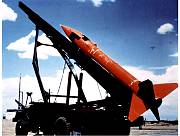
|
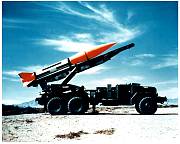
|

|
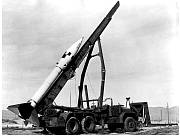
|
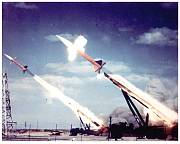
|
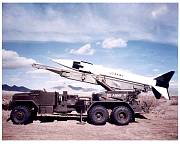
|
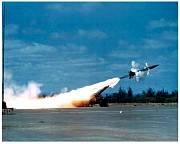
|
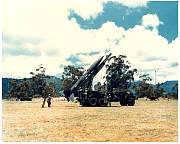
|

